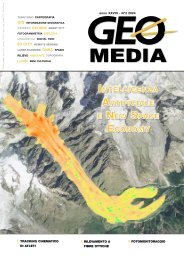You also want an ePaper? Increase the reach of your titles
YUMPU automatically turns print PDFs into web optimized ePapers that Google loves.
GUEST<br />
Q. What additional science<br />
information the discovery<br />
provided?<br />
Several features stand out in the<br />
surface dust disturbances. In<br />
particular there were some bright<br />
patches surrounding the crater.<br />
We were pretty sure there were<br />
large amounts of ice (which was<br />
later confirmed by the HiRISE<br />
team, which acquired higher<br />
resolution images).<br />
Q. How big you think this<br />
event was?<br />
We can piece together a lot<br />
of what happened during this<br />
event. If there had been observers<br />
at Amazonis Planitia, they<br />
would have seen, just after sunset,<br />
a fireball screaming through<br />
the sky from the southwest-tonortheast<br />
and then an explosion,<br />
followed by lots of debris (with<br />
ice) raining down up to 37km<br />
away from the impact site. They<br />
would have felt the ground<br />
shake and two shockwaves (from<br />
the “mach-cone” and the impact<br />
blast).<br />
These impacts are not only the<br />
largest detected on Mars by<br />
MRO, but are also the largest<br />
impacts detected by seismometers.<br />
On Earth, seismometers<br />
have detected atmospheric explosions<br />
associated with impacts,<br />
such as Tungunska in 1908 or<br />
Tcheliabinsk in 2013. But they<br />
exploded at a height of about<br />
20-30 km and left no crater.<br />
Since the advent of seismometers,<br />
both on Earth and Mars,<br />
these Mars craters are record<br />
events: the largest ever detected<br />
jointly by a seismometer and<br />
documented by cameras across<br />
all of the terrestrial planets.<br />
Q. What is the outcome of<br />
the discovery?<br />
When we shared our findings<br />
with the rest of the InSight<br />
team, there was much excitement,<br />
and it led people to<br />
re-examine other seismic events.<br />
In particular, there was an event<br />
from September of 2021 that<br />
had some similarities to the<br />
Amazonis event. This led us to<br />
examine MARCI data in the vicinity<br />
of the estimated epicentre,<br />
and we found a possible candidate<br />
event. We followed this up<br />
with a CTX image and that is<br />
how we discovered the Tempe<br />
Terra crater.<br />
In my view, these craters provide<br />
a simple, straightforward<br />
test of the seismic models that<br />
the InSight team has developed<br />
over the years. On Earth we<br />
use networks of seismic stations<br />
along with known sources to<br />
verify and refine our models. But<br />
on Mars we only have InSight.<br />
These impacts are the first direct<br />
tests of Martian mantle velocity<br />
models. In the upper-mantle,<br />
the models did remarkably well.<br />
For the Tempe Terra impact,<br />
a seismic wave that travelled<br />
The impact crater imaged by HiRISE, the white traces is ice<br />
ejected from the subsurface layers.<br />
deep into the mantle (called<br />
P-diffracted) was observed. With<br />
this wave, the observation didn’t<br />
match as well to our best guess<br />
for the model of the lower mantle,<br />
but that only shows that we<br />
still have some interesting things<br />
to figure out about Mars.<br />
PAROLE CHIAVE<br />
Mars; lower resolution cameras;<br />
CTX; MARCI InSight lander;<br />
marsquake; seismic event;<br />
ABSTRACT<br />
The detection of a seismic event after a meteoric<br />
event happened on Mars. It is the first time in<br />
human history that such an event is recorded.<br />
AUTORE<br />
Fabrizio Bernardini, FBIS<br />
fb@aec2000.eu<br />
Both impact<br />
sites<br />
and InSight<br />
lander<br />
position as<br />
imaged by<br />
MARCI.<br />
The impact crater that produced the first “marsquake” detected by Insight,<br />
as imaged by CTX: it is evident the extent of the ejecta field.<br />
<strong>GEOmedia</strong> n°6-<strong>2022</strong> 27


















